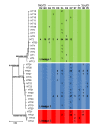Plio-Pleistocene sea level and temperature fluctuations in the northwestern Pacific promoted speciation in the globally-distributed flathead mullet Mugil cephalus
- PMID: 21450111
- PMCID: PMC3079632
- DOI: 10.1186/1471-2148-11-83
Plio-Pleistocene sea level and temperature fluctuations in the northwestern Pacific promoted speciation in the globally-distributed flathead mullet Mugil cephalus
Abstract
Background: The study of speciation in the marine realm is challenging because of the apparent absence of physical barriers to dispersal, which are one of the main drivers of genetic diversity. Although phylogeographic studies using mitochondrial DNA (mtDNA) information often reveal significant genetic heterogeneity within marine species, the evolutionary significance of such diversity is difficult to interpret with these markers. In the northwestern (NW) Pacific, several studies have emphasised the potential importance of sea-level regression during the most recent glaciations as a driver of genetic diversity in marine species. These studies have failed, however, to determine whether the period of isolation was long enough for divergence to attain speciation. Among these marine species, the cosmopolitan estuarine-dependent fish Mugil cephalus represents an interesting case study. Several divergent allopatric mtDNA lineages have been described in this species worldwide, and three occur in sympatry in the NW Pacific.
Results: Ten nuclear microsatellites were surveyed to estimate the level of genetic isolation of these lineages and determine the role of sea-level fluctuation in the evolution of NW Pacific M. cephalus. Three cryptic species of M. cephalus were identified within this region (NWP1, 2 and 3) using an assignment test on the microsatellite data. Each species corresponds with one of the three mtDNA lineages in the COI phylogenetic tree. NWP3 is the most divergent species, with a distribution range that suggests tropical affinities, while NWP1, with a northward distribution from Taiwan to Russia, is a temperate species. NWP2 is distributed along the warm Kuroshio Current. The divergence of NWP1 from NWP2 dates back to the Pleistocene epoch and probably corresponds to the separation of the Japan and China Seas when sea levels dropped. Despite their subsequent range expansion since this period of glaciation, no gene flow was observed among these three lineages, indicating that speciation has been achieved.
Conclusions: This study successfully identified three cryptic species in M. cephalus inhabiting the NW Pacific, using a combination of microsatellites and mitochondrial genetic markers. The current genetic architecture of the M. cephalus species complex in the NW Pacific is the result of a complex interaction of contemporary processes and historical events. Sea level and temperature fluctuations during Plio-Pleistocene epochs probably played a major role in creating the marine species diversity of the NW Pacific that is found today.
Figures





Similar articles
-
Phylogeography of the flathead mullet Mugil cephalus in the north-west Pacific as inferred from the mtDNA control region.J Fish Biol. 2009 Aug;75(2):393-407. doi: 10.1111/j.1095-8649.2009.02332.x. J Fish Biol. 2009. PMID: 20738545
-
A new perspective on biogeographic barrier in the flathead grey mullet (Pisces: Mugilidae) from the northwest Pacific.Genes Genomics. 2020 Jul;42(7):791-803. doi: 10.1007/s13258-020-00942-8. Epub 2020 May 27. Genes Genomics. 2020. PMID: 32462519
-
Diversity and distribution of cryptic species within the Mugil cephalus species complex in Vietnam.Mitochondrial DNA A DNA Mapp Seq Anal. 2017 Jul;28(4):493-501. doi: 10.3109/24701394.2016.1143467. Epub 2016 Feb 24. Mitochondrial DNA A DNA Mapp Seq Anal. 2017. PMID: 27159692
-
An overview of grey mullet (Mugilidae) global occurrence and species-rich ecoregions, with indications of possible past dispersal routes within the family.J Fish Biol. 2023 Aug;103(2):202-219. doi: 10.1111/jfb.15450. Epub 2023 May 30. J Fish Biol. 2023. PMID: 37190911 Review.
-
Global diversity of marine isopods (except Asellota and crustacean symbionts).PLoS One. 2012;7(8):e43529. doi: 10.1371/journal.pone.0043529. Epub 2012 Aug 31. PLoS One. 2012. PMID: 22952700 Free PMC article. Review.
Cited by
-
Historical Refugia and Isolation by Distance of the Mud Snail, Bullacta exarata (Philippi, 1849) in the Northwestern Pacific Ocean.Front Genet. 2018 Oct 22;9:486. doi: 10.3389/fgene.2018.00486. eCollection 2018. Front Genet. 2018. PMID: 30405694 Free PMC article.
-
Population connectivity and phylogeography of a coastal fish, Atractoscion aequidens (Sciaenidae), across the Benguela Current region: evidence of an ancient vicariant event.PLoS One. 2014 Feb 20;9(2):e87907. doi: 10.1371/journal.pone.0087907. eCollection 2014. PLoS One. 2014. PMID: 24586296 Free PMC article.
-
Cryptic genetic diversity in the mottled rabbitfish Siganus fuscescens with mitochondrial introgression at a contact zone in the South China Sea.PLoS One. 2018 Feb 21;13(2):e0193220. doi: 10.1371/journal.pone.0193220. eCollection 2018. PLoS One. 2018. PMID: 29466431 Free PMC article.
-
Cryptic diversity in the Japanese mantis shrimp Oratosquilla oratoria (Crustacea: Squillidae): Allopatric diversification, secondary contact and hybridization.Sci Rep. 2017 May 16;7(1):1972. doi: 10.1038/s41598-017-02059-7. Sci Rep. 2017. PMID: 28512346 Free PMC article.
-
Mitochondrial DNA patterns describe the evolutionary history of the bonnethead shark Sphyrna tiburo (Linneus 1758) complex in the western Atlantic Ocean.J Fish Biol. 2025 Feb;106(2):403-419. doi: 10.1111/jfb.15961. Epub 2024 Oct 15. J Fish Biol. 2025. PMID: 39404156 Free PMC article.
References
-
- Haig JA, Connolly RM, Hughes JM. Little shrimp left on the shelf: the roles that sea-level change, ocean currents and continental shelf width play in the genetic connectivity of a seagrass-associated species. J Biogeog. 2010;37:1570–1583.
Publication types
MeSH terms
Substances
LinkOut - more resources
Full Text Sources

